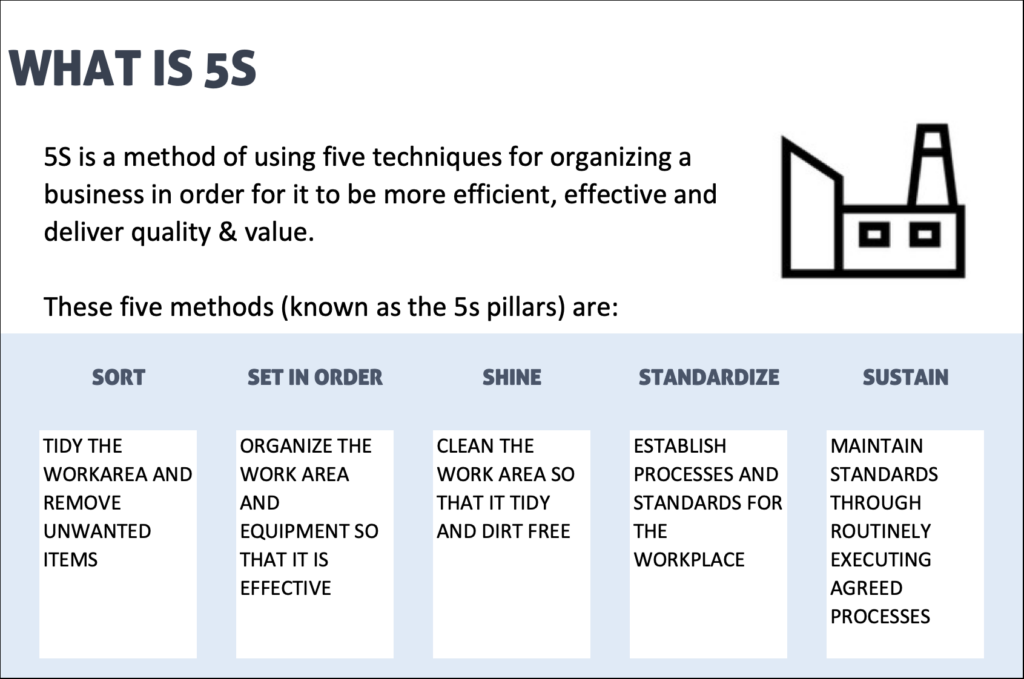5S is a method of using five techniques for organizing a business in order for it to be:

- More efficient
- More effective at delivering value
- Have high levels of safety
These five methods (known as the 5s pillars) are:
- Sort
- Set in order
- Shine
- Standardize
- Sustain
In today’s article, we’ll be covering the basics of 5s, what it is, how to use it and how to get the best return.
We’ll be looking into:
- What is 5s
- Sort
- Shine
- Standardize
- Sustain
- Benefits of 5s
- Who carries out 5s tasks
What is 5s
The 5S methodology can be applied to any area in the business (from office to production). It utilizes visual and lean management techniques to deliver returns back to the company.
5s places focus on a place for everything and everything in its place and maintaining clear workspaces designed for efficiency.
The result is jobs that are easier, more effective, and safe.

5s is based on 5 Japanese terms that have been matched to their English counterparts. Each of the “S’s” represents a step in the process.
- Seiri – sort
- Seiton – set in order
- Seiso – shine
- Seiketsu – standardise
- Shitsuke – sustain
5S originates from within the Toyota Production System (TPS); the system combines two key elements:
- Increased value is provided to customers through an organization’s products or services.
- Elimination of waste from within company processes
5S (used in combination with other lean tools) is considered a central part of the Toyota Production System.
Disorganized, messy work areas can lead to several issues, such as
- Errors
- Lead time issues such as duration and interruptions.
- Safety concerns
Whereas a clean, well-organized environment helps underpin highly efficient and effective processes.
5S aims to provide a framework on which a business can establish processes that keep the workplace organized.
A highly organized business helps increase the probability that processes will be executed as they should
What are the 5s’s
Sort
Sort requires a business to review work areas, tools, and equipment to see what needs to be there and what doesn’t (and can be eliminated).
This section can be facilitated by asking several questions of the operators within the area that can help derive the true value or usefulness of the item; these include:
- Does the item have a purpose
- When was the item used last?
- Which function or operator uses the item?
- Is it used regularly?
Items that score poorly against these types of questions may add little value to the functional area.
Tools like the red tag system can be used to help define the usefulness of equipment found in a location.
Set in order
Once the equipment has been assessed, the remaining items can be reviewed to consider their most optimal placement.
The 5s team can ask questions to aid with the task; these can include:
- Where and when are the items used
- Are the items used by particular operators?
- Is the equipment used in a particular sequence?
- Which pieces of equipment are used most often
- How are these items retrieved
This assessment will help define where the most logical place is to put items and how they should be arranged.
The output of this section is several:
- Placement of equipment should capitalize on the best ergonomics for the operators
- Reducing motion and movement by the operator in the retrieval of the items
- Optimized storage (i.e., shadow boards, shelves, boxes, or containers)
During this phase, participants can determine the most appropriate arrangements (bearing in mind that this assessment is not a one-off and should be under constant review).
Shine
The Shine stage of 5S focuses on improving the cleanliness of the work area. This usually includes:
- Sweeping floors and walkways,
- Cleaning surfaces,
- Putting tools and equipment away in their designated area
- Undertaking preventative maintenance on appropriate equipment (This can help catch issues ahead of them arising, reducing lost time due to breakdowns).
Standardize
Standardize helps establish 5s as a routine process; it achieves this by:
- Creating routine tasks with owners
- Developing a schedule describing when tasks are executed
- Documenting processes, checklists, and instructions
- Communicating through the use of posters, signs, and markings.
- Establishing roles and responsibilities with regards to carrying out 5s tasks
Sustain
5s is not a one-off activity. An organization that implements 5s needs to ensure it is sustained in order to deliver ongoing value.
Sustainment involves
- Maintaining repeating 5s activities
- Maintaining procedures & associated documents to keep them current
- Driving participation of staff
- Monitoring results
Where is 5s carried out?
Many people consider 5s a production or machinery focused task, with it being predominantly carried out in
- Manufacturing areas
- Logistics/Warehousing
In fact, 5s can be carried out throughout the whole organization, with each of the five methods being applied everywhere within the business from manufacturing centers through to office space.
What are the benefits of 5s?
We’ve written a separate article on Benefits of 5s which you can check out via the link.
In summary, benefits include
- Efficiency
- Improved Saftey
- Staff engagement
- Cost savings
- Improved Quality
- Reduced Lead times.
Who does 5s tasks?
5S is the responsibility of the whole organization
Everyone has responsibility for its delivery; it is a constant ongoing task that should happen daily.
Some training is likely to be needed (especially where specialist cleaning products are needed)
Some tasks (i.e., preventative maintenance) will need to be carried out by appropriately skilled and trained staff.
Engagement drives ownership which in turn can help sustainment.
Summary
5s is a key part of lean management and can help establish a baseline upon which other improvement activities can be built.
It is not complex but can drive tangible results.
Through the fact that it involves all members of staff, it can help inform team members of the role of lean and continuous improvement and drive engagement of staff to actively participate.
How is 5s deployed in your organization? What has been the impact? Do you have tips that you’d like to share?
As ever we’d love to hear from you.
This article is part of our Lean Guide.

1 thought on “What is 5s”
Comments are closed.